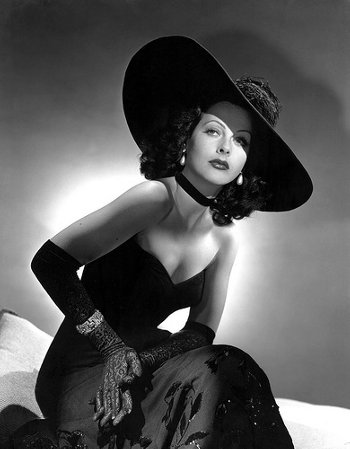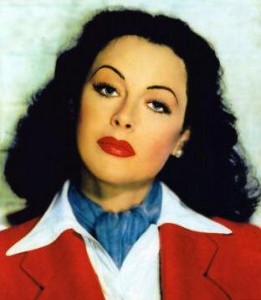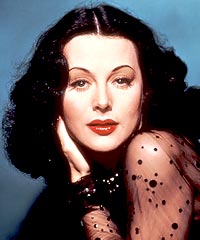 While he was growing up in Ottawa, Illinois, the film writer Stephen Shearer’s mother told him that in 1939 she and a girlfriend went to the local cinema to see Charles Boyer in “Algiers.” Co-starring with the Frenchman was MGM’s latest European import, Hedy Lamarr.
While he was growing up in Ottawa, Illinois, the film writer Stephen Shearer’s mother told him that in 1939 she and a girlfriend went to the local cinema to see Charles Boyer in “Algiers.” Co-starring with the Frenchman was MGM’s latest European import, Hedy Lamarr.
In her first appearance in the film, cinematographer James Wong Howe shoots Lamarr, known as “The Most Beautiful Girl in the World,” in deep shadow. As she approaches the camera, her face emerges in the light.
“The entire audience gasped,” Shearer’s mother recalled. Hedy Lamarr was that beautiful.
And they didn’t make ’em like that in Ottawa, Illinois.
I learned this fun nugget at a book talk at Larry Edmund’s Bookshop on Hollywood Boulevard, celebrating Shearer’s new biography “Beautiful: The Life of Hedy Lamarr.” The Austria-born actress was among the many German-speaking Jewish artists who made their way to California in the 1930s.
 Born Hedwig Kiesler, Lamarr was a celebrity in Europe before coming to the U.S. — notorious for bobbling in the buff in “Ecstasy” (1933). In 1937, anticipating the Anschluss (Shearer intimated that Lamarr was well connected in political circles), she and her husband departed Vienna. Meeting L.B. Mayer in London (he was in town scooping up European talent, to his credit, much of it Jewish), she inked her MGM contract.
Born Hedwig Kiesler, Lamarr was a celebrity in Europe before coming to the U.S. — notorious for bobbling in the buff in “Ecstasy” (1933). In 1937, anticipating the Anschluss (Shearer intimated that Lamarr was well connected in political circles), she and her husband departed Vienna. Meeting L.B. Mayer in London (he was in town scooping up European talent, to his credit, much of it Jewish), she inked her MGM contract.
As the duo plowed across the pond aboard the S.S. Normandie, Mayer renamed his exotic charge, so the legend goes, after Barbara La Marr, the heroin-addled silent film actress. In an alternate version, which I prefer, the multilingual Lamarr gazed at the sea through her gorgeous eyes and murmured, “La mer!”
A star — Lamarr — was born.
One other charming detail of that crossing is that L.B. dispatched Hedy — who more or less had a knapsack and about 80 bucks to her name — to the ocean liner’s Chanel boutique on the first-class deck. There, on MGM’s dime, Lamarr was suited up for the mob of press awaiting the Normandie’s arrival in New York harbor.
Shearer noted that Mayer mismanaged Lamarr’s career. He was gifted at dolling up homegirls like Garland and Turner into cinema royalty. But in casting an elegant, intelligent, sophisticated woman like Lamarr, L.B. was flatfooted. This problem is amusingly addressed in “What Not to do with Hedy Lamarr,” LIFE magazine, August, 1939.
* * *
I’m a big fan of Cecil B. DeMille’s “Samson & Delilah” (1949); one reason why is the gorgeous Hedy Lamarr’s precise performance. Leafing through the “Samson” files at the DeMille archives while investigating Theodore Kosloff‘s choreography of the epic, I came across a telegram Hedy sent to DeMille. Holding the fragile paper in my hands, I read the words of a woman sitting on top of the world.
———-

Interesting article, surprised you did not mention her mathematical skills (see excerpt below from Wikipedia).
(Former husband) Antheil played an important role in Lamarr’s life in another way as well—as a collaborator on an important electronics innovation. Lamarr was slightly dismissive of her glamorous image, saying (according to her U.S. News & World Report obituary), “Any girl can be glamorous. All you have to do is stand still and look stupid.” Lamar, by contrast, had been astute enough to pick up a good deal of practical knowledge pertaining to munitions engineering during her marriage to Mandl. In 1940 she had the idea for a solution to the problem of controlling a radio-guided torpedo. At that time, electronic data broadcast on a specific frequency could easily be jammed by enemy transmitters. Lamarr suggested rapid changes in the broadcast frequency, and Antheil, who had experimented with electronic musical instruments, devised a punch-card-like device, similar to a player-piano roll, that could synchronize a transmitter and receiver. The system Lamarr and Antheil invented relied on using 88 frequencies, equivalent to the number of keys on a piano.
The pair were jointly awarded a patent for their discovery, but Antheil later credited the original idea entirely to Lamarr. Credit did not matter, however, for the idea, later given the name of frequency hopping, was never applied by the military during World War II. It was later rediscovered independently and used in ships sent to Cuba during the missile crisis of 1962. The real payoff of frequency hopping came only decades later, when it became integral to the operation of cellular telephones and Bluetooth systems that enabled computers to communicate with peripheral devices. By that time, Lamarr and Antheil’s patent had long since expired.
I always heard that her husband was evil and she shimmied out the window during a dinner party to get away from him. I guess I’ll have to read the biography to get the better story. And I love the opening tale! That sounds about right, don’t you think? I may have done the same thing the first time I ever saw her as well. She was really something to look at.